
Public TRT Plots for Collision Data
- Introduction
- Papers
- Public notes and plots
- Notes of explanation
- TRT performance results from 13 TeV collision data (2015/2016) (03 August 2016)
- Results from 900 GeV collision data [Argon straws, Barrel only] (6 May 2015)
- Results from 8 TeV collision data (2012)
- Results from 7 TeV collision data (2010/2011)
- Test Beam-Simulation plots
- Results from 900 GeV collision data (December 2009)
Introduction
This page shows approved plots that demonstrate ATLAS TRT detector performance in collision data and can be shown by speakers at conferences and similar events.If you are interested in having additional plots approved or in case of questions and/or suggestions, please contact the responsible project leader. See also ATLAS approval plots procedure.
Papers
Performance of the ATLAS Transition Radiation Tracker in Run 1 of the LHC: tracker properties:Journal of Instrumentation, Volume 12, P05002
Public Plots IDET-2015-01
Public notes and plots
Performance of TRT Fast-OR trigger in 2023 HI run:IDET-2023-01
ATL-INDET-INT-2020-006
Public plots TRT-2016-001
ATL-INDET-PUB-2014-001
ATL-COM-PHYS-2013-1348
ATL-COM-PHYS-2012-1544
ATL-COM-PHYS-2012-468
ATLAS-CONF-2012-042
ATLAS-CONF-2011-128
ATLAS-CONF-2011-012
ATLAS-CONF-2011-006
Notes of explanation
Any plots shown in this section are not necessarily "public"; they are intended to help explanations only. Coverage: The following two sets of pseudorapidity (η) ranges are commonly used in studies:- |η|<0.625 (tracks entirely in the TRT barrel),
- 0.625<|η|<1.070 (tracks spanning the service region between the barrel and end-cap),
- 1.070<|η|<1.304 (tracks in the type A end-cap wheels),
- 1.304<|η|<1.752 (tracks spanning the type A and B end-cap wheels),
- 1.752<|η|<2.0 (tracks entirely in the type B wheel region).

 See also:
See also:
- ATLAS public results
- Inner Detector public results
- TRT cosmic results
- TRT TWiki
- More TRT results in preparation for approval (ATLAS internal)
TRT performance results from 13 TeV collision data (2015/2016) (03 August 2016)
The most recent available plots can be seen here Public plots TRT-2016-001Results from 900 GeV collision data [Argon straws, Barrel only] (6 May 2015)
|
Overview Plots made with data from run 264034 (6 May 2015) – physics_MinBias stream – reconstruction tag f578 (collisions set-up with tracking commissioning settings) – 900 GeV collisions, TRT filled with Argon in all straws 70%Ar, 27%CO2 and 3%O2. Track selection: – pT > 0.5 GeV – at least one silicon hit – at least 10 TRT hits Statistics: in total 230M hits on track passing this selection. | |
|
Time distribution on track(Barrel) For any triggered event, the TRT reads out data over three bunch crossing periods with each crossing period divided in eight time-bins. For each TRT straw, the information about whether the signal exceeds the threshold or not is thus recorded in bins of 3.12 ns. The first 0 to 1 transition marks the leading edge (LE) of the signal (hit). The drift time is defined as the leading-edge time, corrected for an offset described by a time calibration constant and corresponds to the time it takes for the closest primary electron cluster to drift to the wire. |
 png file / pdf file |
|
Number of LL hits on track in time window Number of hits on track where the signal exceeds the low level(LL) threshold within a time window of [14.06,42.19] ns. The time window requirement preferentially rejects hits from out of time bunch crossings. The average number of TRT hits on tracks extracted is 31. |
 png file / pdf file |
|
Position residuals The TRT unbiased hit residual distribution for the barrel as obtained from 900 GeV collision data, with all TRT straws filled with Argon gas. The residual is defined by the difference between the drift radius extracted from the drift time and the track radial position, measured for precision hits. The width as stated in the inlay was determined from an iterative fit resulting in a fit in the region of 1.5 sigma around the central value. The uncertainty of the width is less than 0.1 µm in all cases. The mean of the fit is smaller in absolute value than 1 µm and is not shown. Tracks for the position determination were selected to have pT > 0.5 GeV, at least one silicon hit and at least 10 TRT hits. For these low-momentum tracks, the width of the residual distribution is larger than the intrinsic accuracy per hit expected from the drift-time measurement because of the contribution from multiple scattering to the track parameter errors. More data are required to improve the overall alignment of the inner detector and of the TRT. For a comparison with Xenon based mixture in 2011 data, see #TRTPublicResults#Results_from_7_TeV_collision_dat |
 png file / pdf file |
|
Time residuals Time residual distributions for TRT barrel as obtained from 900 GeV collision data with all TRT straws filled with Argon gas. The time residual is defined as the difference between the leading-edge time, corrected for an offset described by a T0 calibration constant, and the expected drift-time estimated from the track position (for details see ATLAS-CONF-2011-006 For a comparison with Xenon based mixture in 2011 data, see #TRTPublicResults#Results_from_7_TeV_collision_dat |
 png file / pdf file |
|
TRT R(T) relation This plot shows the TRT R-T dependency for the TRT barrel as obtained from 900 GeV collision data with all TRT straws filled with Argon gas. This relation is used to infer track to wire distance, i.e., drift radius, based on measured drift time. To determine the R-T relation, the raw time measurement is first corrected with a T0 calibration constant. This way, different signal delays for different parts of the detector are taken into account. In the next step, the track to wire distance distribution is fit in bins of measured drift time. The tracks are required to have pT > 0.5 GeV, at least one silicon hit and at least 10 TRT hits. For a comparison with Xenon based mixture in 2011 data, see #TRTPublicResults#Results_from_7_TeV_collision_dat |
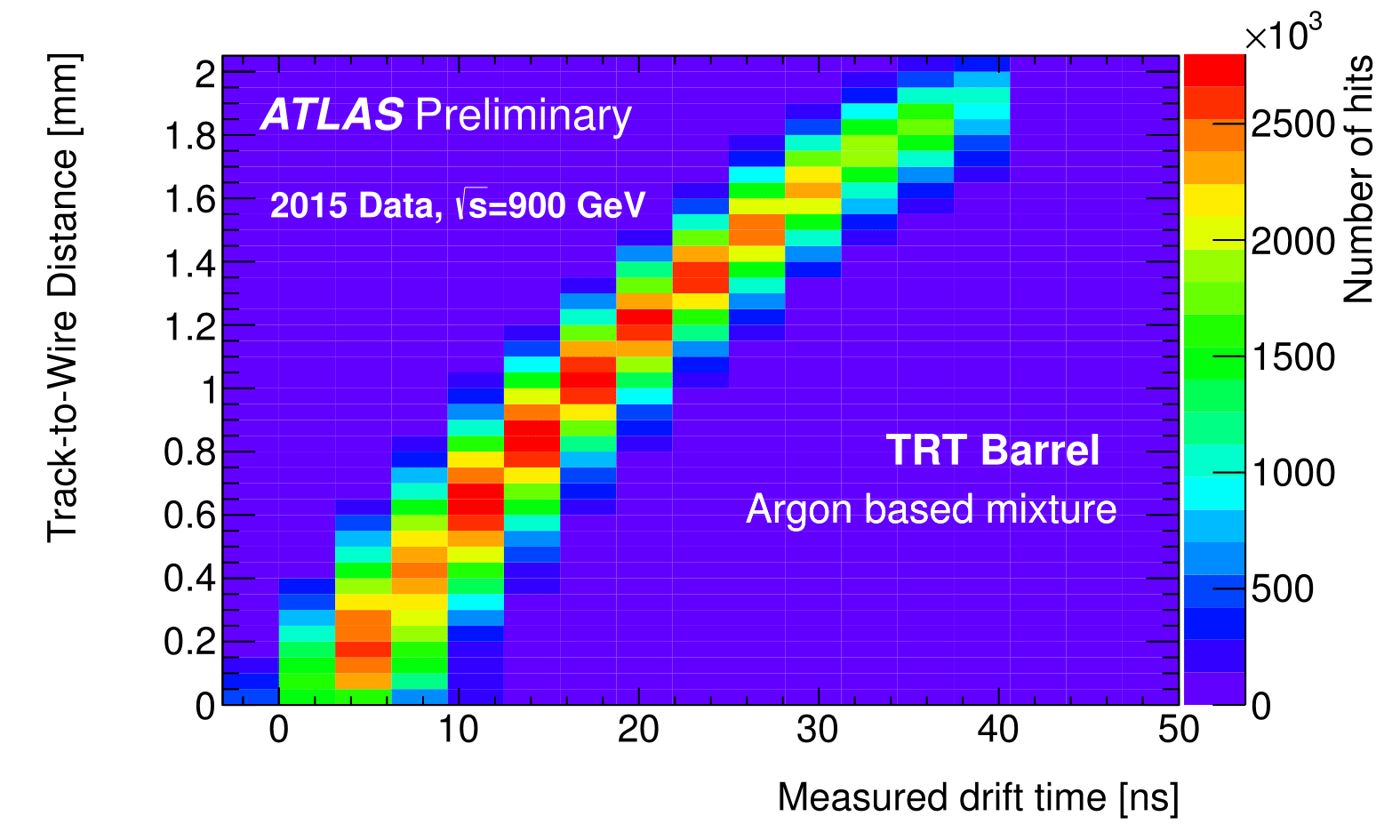 png file / pdf file |
Results from 8 TeV collision data (2012)
border=1 cellpadding=10 cellspacing=10>|
Performance of the TRT PID capabilities with pileup The fraction of high threshold TRT hits on track for electron candidates is given as a function of expected pileup in different eta sections of the TRT. Pileup is quantified either by the number of primary vertices reconstructed by the inner detector or the average number of interactions per bunch crossing, which is proportional to LHC instantaneous luminosity. The absolute HT fraction varies across eta regions based on the amount of TRT radiator material traversed. data selection:
 is defined as the average interactions per bunch crossing averaged over a given lumi block and BCID is defined as the average interactions per bunch crossing averaged over a given lumi block and BCID The plots were made separately for 5 different regions in eta corresponding to Barrel, Barrel/EndcapA, Endcap A, Endcap A/B and Endcap B |
|
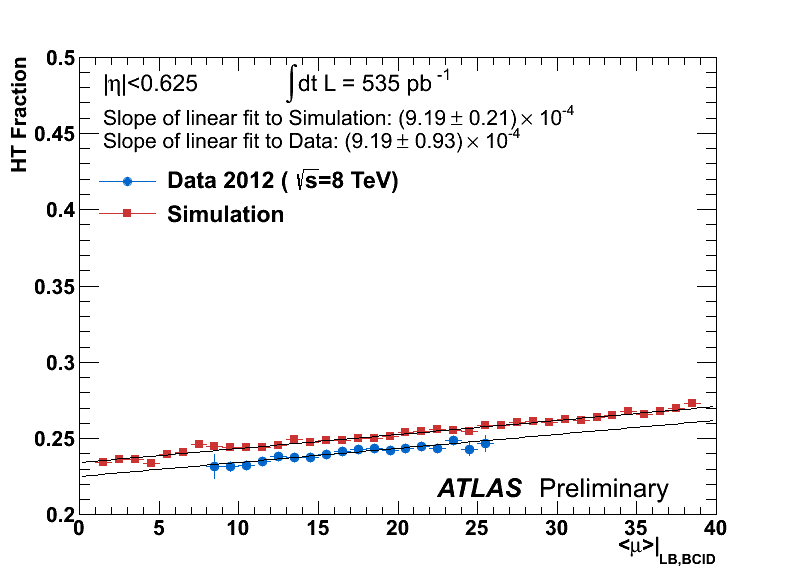 eps file (NVtx) eps file (mu) 0.625<| 
 eps file (NVtx) eps file (mu) 1.07<| 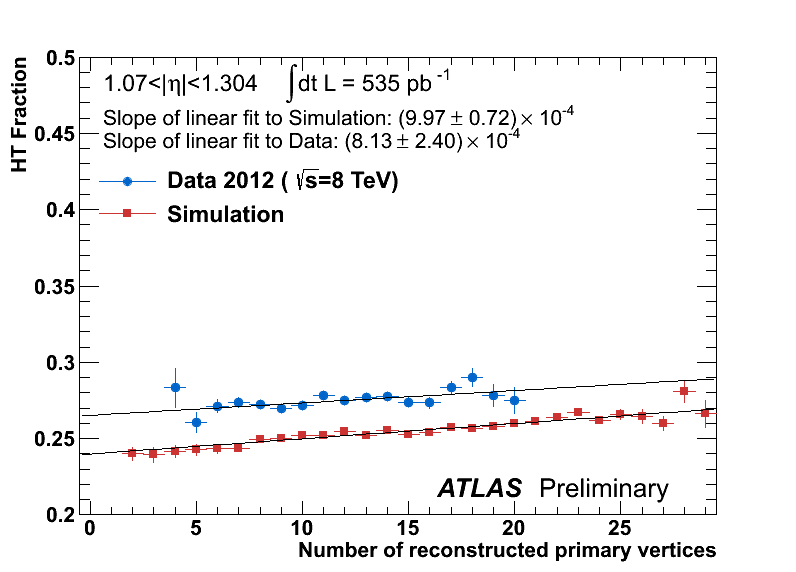
 eps file (NVtx) eps file (mu) 1.304<| 
 eps file (NVtx) eps file (mu) 1.752<| 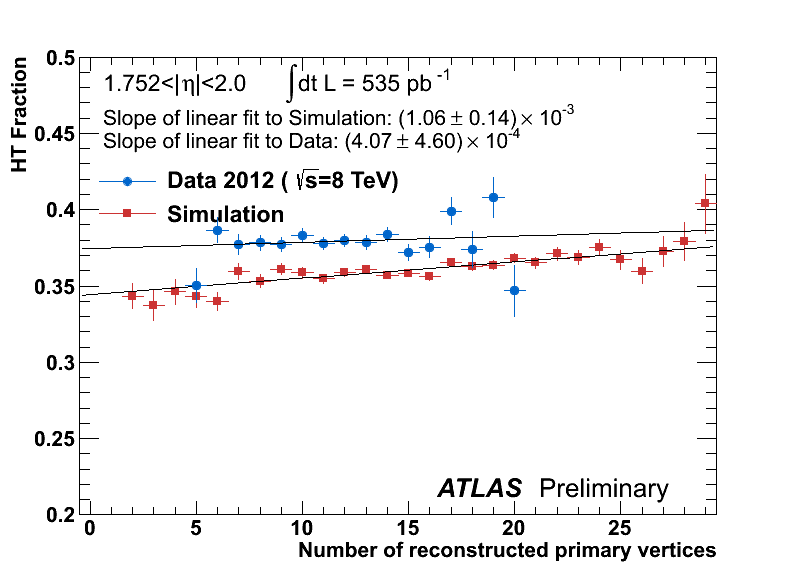
 eps file (NVtx) eps file (mu) |
Results from 7 TeV collision data (2010/2011)
border=1 cellpadding=10 cellspacing=10>|
Pion rejection vs eta Pion misidentification probability for HT fraction criteria that give 90% electron efficiency in bins of eta. This plot is an update of a public plot where only the result for data was shown. The simulated sample was analyzed in the same way as the data sample. The detector performance exceeds the simulation-based expectations, in particular in the end-cap region (|eta| > 0.8). For more information on the analysis, selection criteria, data - simulation comparisons and other related results see ATLAS-CONF-2011-128. |
 eps file |
|
Time residuals Time residual distributions for TRT barrel and end-caps. The time residual is defined as the difference between the leading-edge time, corrected for an offset described by a T0 calibration constant, and the expected drift-time estimated from the track position (for details see ATLAS-CONF-2011-006). The resolution was determined in an iterative fit procedure with a single gaussian in the range of +/- 1.5 sigma around the mean. The mean position of the gaussian reflects different T0 positions in data and MC. The observed widths of the distribution are 3.0 (3.1) ns in data and 3.1 (2.9) ns in MC in the barrel (end-cap) region. Tracks for the position determination were selected to have pT > 2 GeV, |do| < 10 mm, |zo| < 300 mm and at least 15 TRT hits. The comparison with simulation is based on a dijet PYTHIA MC. |
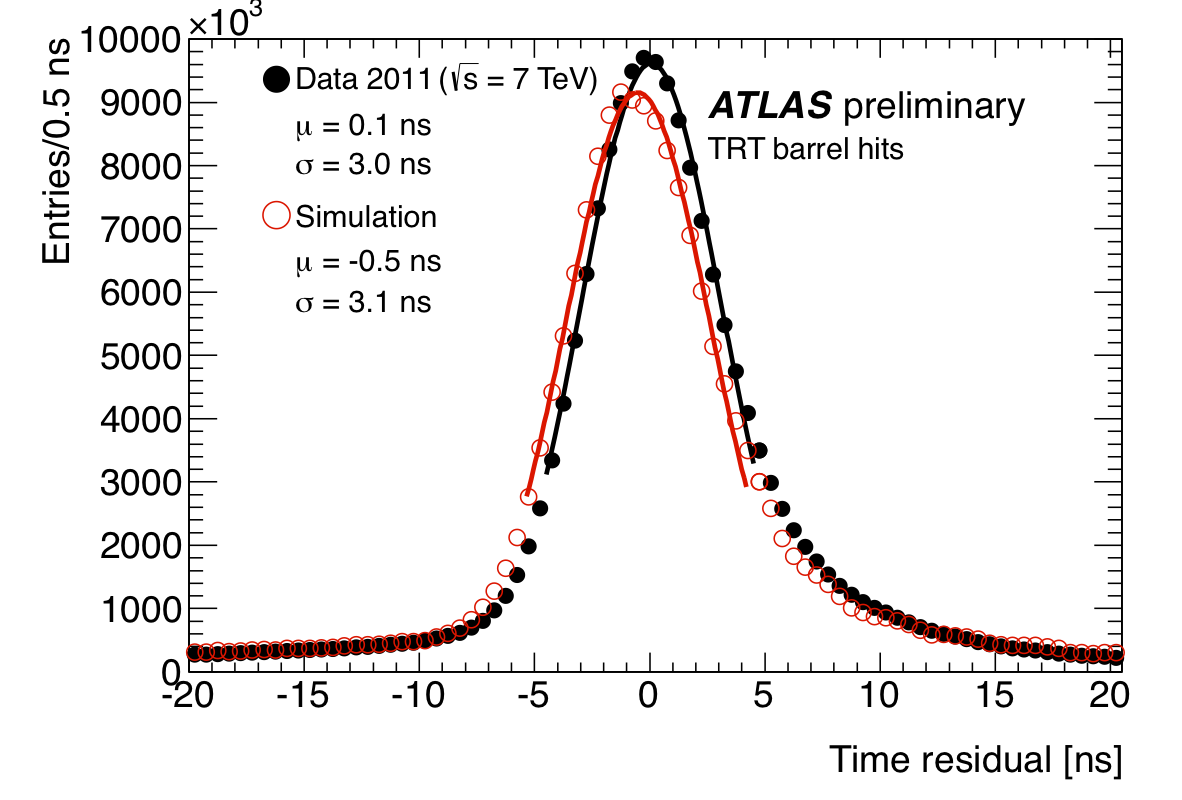 eps file  eps file |
|
Hit Residuals The hit residual distribution for barrel long straws, end-caps and barrel short straws. The short straws, for which the central part of the straw is not read out, have significantly lower occupancy. The residual is defined by the difference between the drift radius extracted from the drift time and the track radial position, measured for precision hits. The full histogram shows the MC simulation and the points the data. The width as stated in the inlay was determined from an iterative fit resulting in a fit in the region of 1.5 sigma around the central value. The uncertainty of the width is less than 0.1 μm in all cases. Tracks for the position determination were selected to have pT > 2 GeV, |do| < 10 mm, |zo| < 300 mm and at least 15 TRT hits. For these low-momentum tracks, the width of the residual distribution is larger than the intrinsic accuracy per hit expected from the drift-time measurement because of the contribution from multiple scattering to the track parameter errors. The comparison with simulation is based on a dijet PYTHIA MC. |
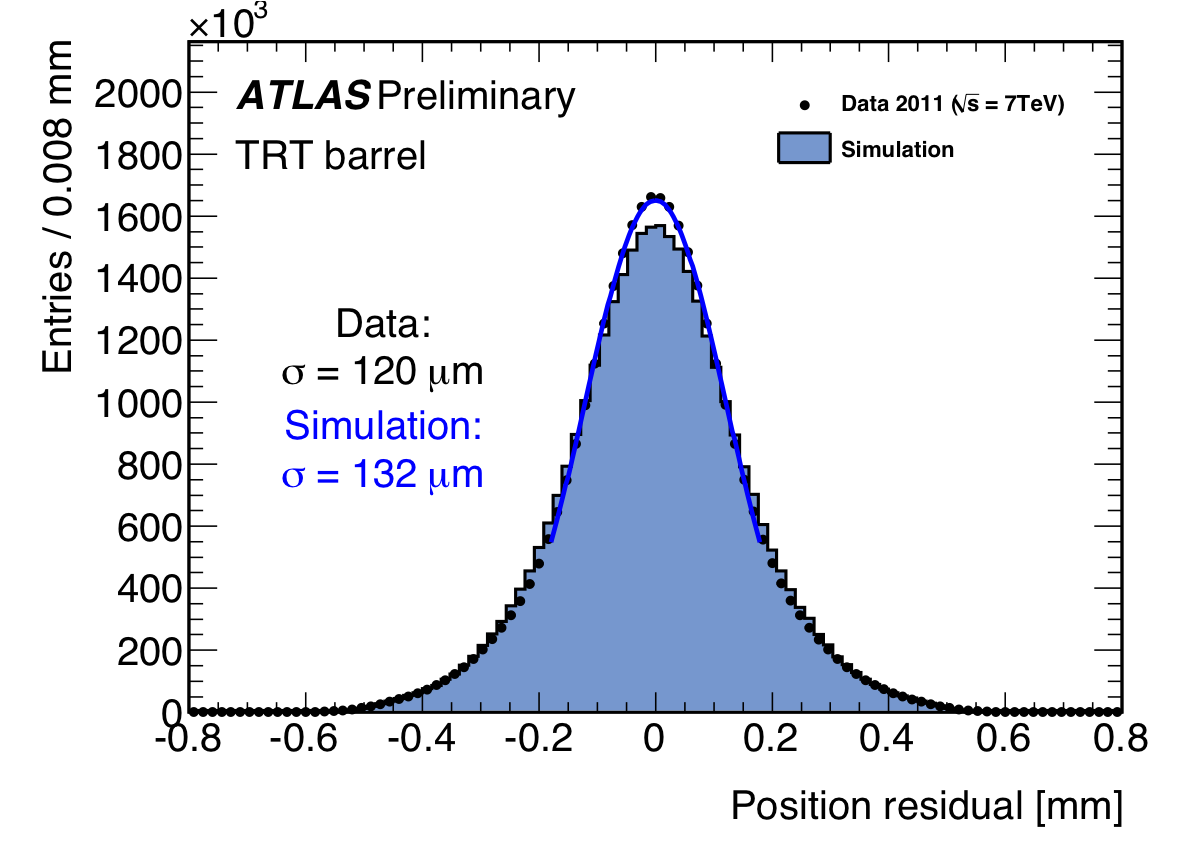 eps file  eps file  eps file |
|
Hit Occupancy Low-level hit occupancy and high-level hit occupancy for different numbers of reconstructed primary vertices. The plots show the average for the three straw layers with highest and lowest occupancy in the barrel and end-cap regions of the detector. This should represent the possible range of occupancy. The points show the distribution where the line is the Monte Carlo simulation. The observed offset differences in the barrel region can be associated to different noise levels and different physics at hard scatter, whereas differences in slope represent differences between data and simulation in the Minbias process and vertex finding efficiency. |
 eps file  eps file |
|
Position Residuals Position residual width as a function of track pt for data and Monte Carlo for barrel (top) and endcap (bottom). Residuals rise at lower pt due to increased scattering of the track. |
 eps file  eps file |
|
Position Residuals vs primary vertices Position residual width as a function of the number of reconstructed primary vertices found in the event. A track pt cut of 10 GeV is required so that the pt spectrum of tracks does not significantly change with added vertices. |
 eps file |
|
Position Residual Maps Position residual width as a function of R and Z in data for barrel (top) and endcap A (bottom). The widening of residuals at large Z and large radius is reproduced by the simulation. |
 eps file  eps file |
|
Tube Hit Fraction Fraction of TRT hits on track that are tube hits as a function of track pt, shown for events with different numbers of reconstructed primary vertices. |
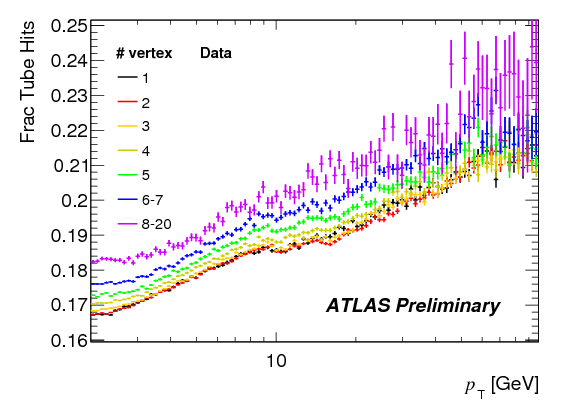 eps file |
|
Occupancy Average occupancy and high threshold occupancy in data in the barrel and endcaps as a function of barrel straw layer and endcap wheel. Occupancies are shown for different numbers of reconstructed primary vertices. The first nine straw layers in the barrel are short straws, which have lower occupancy. The points with lowest occupancy correspond to events with zero reconstructed primary vertices. The highest points correspond to 11 reconstructed primary vertices. |
 eps file  eps file  eps file 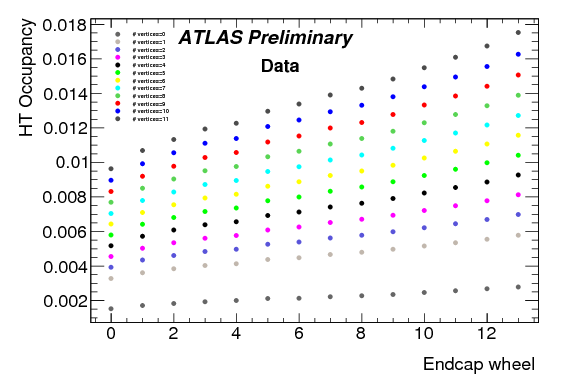 eps file |
|
Delta Occupancy Change in average (high threshold) occupancy with an added additional reconstructed primary vertex in the barrel and endcaps as a function of barrel straw layer and endcap wheel. The additional occupancy with every added reconstructed vertex is a measure of the in-time background added by every minbias interaction. The first nine straw layers in the barrel are short straws, which have lower occupancy. |
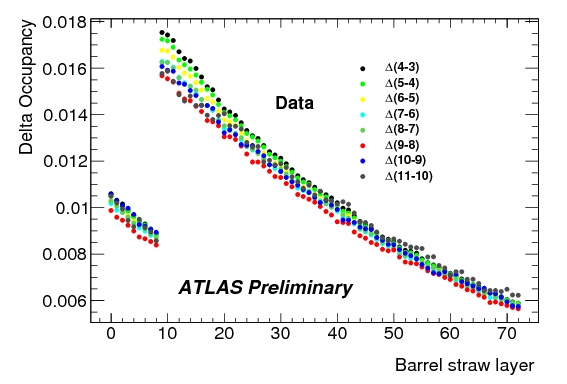 eps file  eps file 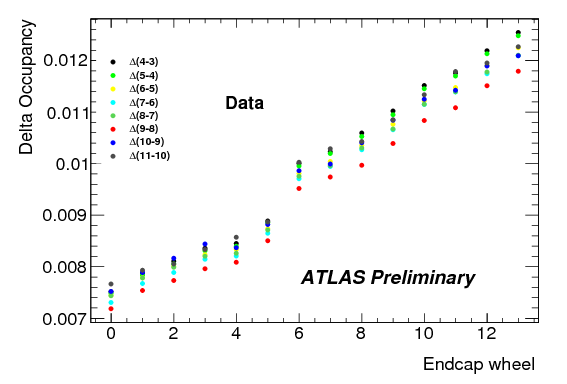 eps file  eps file |
|
Predicted Occupancy Predicted in-time (high threshold) occupancy as a function of barrel straw layer and endcap wheel for different values of pileup. The occupancies are calculated by using the delta occupancy plots to estimate the probability of a hit from an interaction. The first nine straw layers in the barrel are short straws, which have lower occupancy. |
 eps file  eps file  eps file  eps file |
|
ToT-based dE/dX estimator The following plots show an estimator for specific energy loss based on the Time over Threshold (ToT) measured by the TRT. The estimator demonstrates the capability to use ToT as a variable for particle identification for heavily ionizing particles. The TRT measures the time when the signal exceeds low threshold in bins of 3.12 ns. The estimator is formed using the ToT measurement of all TRT hits on track. First, the average ToT for minimum ionizing particles (minimum bias tracks between total momenta of 2 GeV and 10 GeV) is found as a function of the track position in the straw (ToTmip), and then the average sum of the difference between the two, Σ(ToT -ToTmip)/Nhits, is used as the estimator. The estimator is offset to be equal to 1 for minimum ionizing particles. Finally, corrections for variations with pseudo-rapidity are made for hits on tracks in the barrel and end-cap. When plotted vs. the total momentum the dE/dx estimator shows the typical Bethe-Bloch rise for kaons, protons and deuterons. A sample of approximately 17 million tracks collected during one run (155160) of 7 TeV collisions is used. The tracks are required to have at least one pixel, at least six SCT, and at least 15 TRT hits. The range of 0 <|eta|< 2 that is used includes both barrel and end-cap regions of the detector. Track impact parameters are used to select 15.7M tracks from the primary vertex:|d0| < 1 mm and |z0 sin(θ)| < 1 mm. Reversing both of these cuts gives 1.7M tracks not associated with the primary vertex and dominated by secondaries from hadronic interactions and conversions in the beam pipe and detectors. There are far more protons and deuterons than their corresponding antiparticles observed in this sample. |
 eps file  eps file |
|
TRT R-T relation
These plots show the TRT RT dependency for the TRT barrel and end-caps. This relation is used to infer track to wire distance, i.e., drift radius, based on measured drift time. To determine the R-T relation, the raw time measurement is first corrected with a T0 calibration constant. This way, different signal delays for different parts of the detector are taken into account. In the next step, the track to wire distance distribution is fit in bins of measured drift time. The peak position obtained with this fit is shown in blue points in the figures. The dependency of the peak position on measured drift time is described by a third order polynomial, shown in the black line. The curve is slightly different in the end-caps due to the different orientation of the straws and small variations in the magnetic field. The tracks are required to have at least 6 hits in SCT and at least 20 hits in the TRT. |
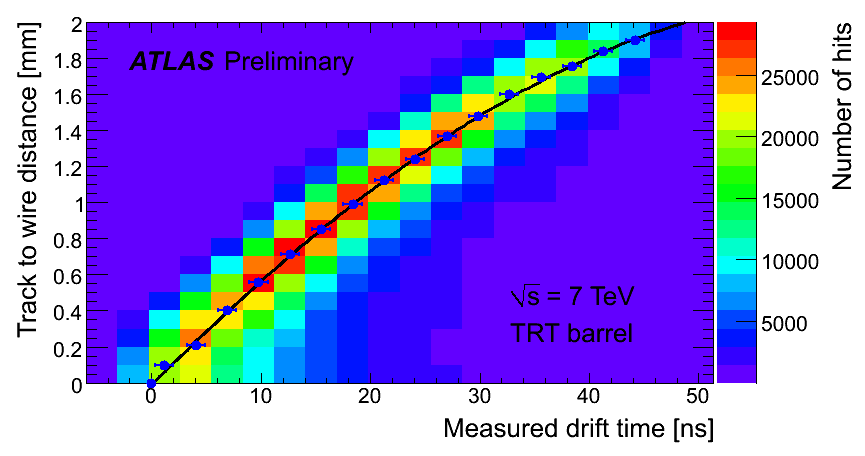 eps file  eps file |
|
Transition radiation onset The plots show the probability of a TRT high-threshold (HT) hit as a function of the Lorentz factor, γ = E/m, for the TRT barrel and end-cap regions, as measured in 7 TeV collision events, runs 152994 - 153565. At high values of γ (above γ=1000), a pure sample of electrons is obtained from photon conversions. For low values of gamma, all selected tracks in the event are used and are assumed to have the mass of the charged pion. As expected from the production of transition radiation (TR), the probability of a HT hit increases for particles with a gamma-factor above 1000, which enables the TRT to separate electrons from pions over a momentum range between 1 GeV and 150 GeV. The conversion candidates are required to be pairs of oppositely charged tracks, both of which originate from the same vertex, where this vertex is more than 40 mm away from the beam axis. Both tracks are required to have at least four silicon hits and 20 TRT hits. When one track is identified as an electron (fraction of HT hits > 0.12), the other track is considered to be an electron candidate. The pion candidates are required to have at least one b-layer hit and 20 TRT hits. To minimize the contamination of electrons, these tracks are required not to overlap with any conversion candidates. The number of conversions increase and have a higher momentum spectrum in the end-caps due to the increased amount of material and boost in the forward directions. The results indicate that the onset of TR from the lower plateau (corresponding to the probability of producing high-energy delta-rays) and the upper plateau (corresponding to the saturation of the transition radiation production in the geometry chosen for the TRT radiators foils and straw tubes) in the end-cap is steeper than for the barrel. This is expected from test-beam measurements and from the different radiator materials used for the barrel (irregularly spaced fibres) and end-caps (regularly spaced foils). The results agree with those obtained from minimum bias Monte Carlo simulation for almost all values of gamma and provide the TRT detector with an excellent starting point to study and optimize its particle identification properties. The simulation of the transition radiation has so far been tuned on data collected with barrel modules only in 2004 on a test beam setup and can now be improved based on new results from collision data. The simulated sample is observed to have slightly higher HT probability for hadrons and lower HT probability for electron candidates in the end-caps, where larger number of conversion candidates allows the comparison. |
 eps file 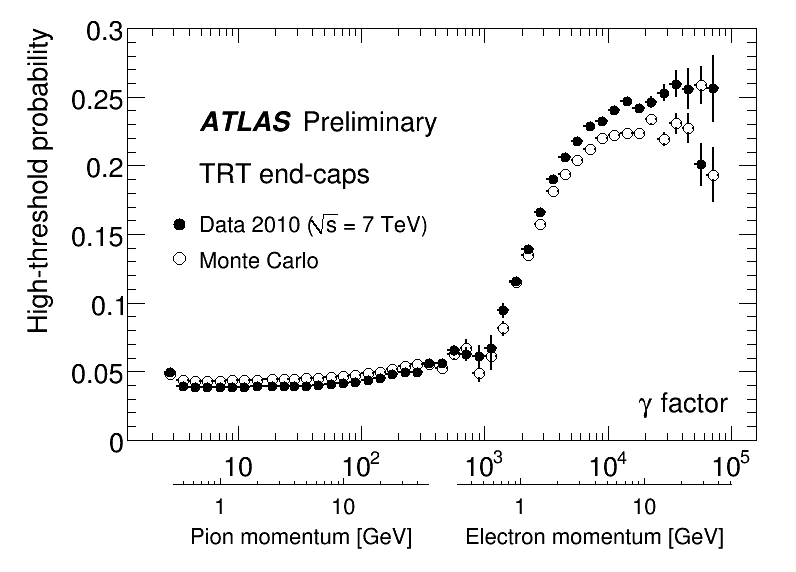 eps file |
|
TRT hit efficiency The following plots show the TRT hit reconstruction efficiency as a function of distance of closest approach of the track to the straw centre. The hit reconstruction efficiency is defined as the number of straws with a hit on track divided by the number of straws crossed by the track. Only straws between the first and the last straws with a reconstructed hit on the track are considered in the efficiency calculation, excluding the first and the last. The 2% of known non-functioning straws are excluded from this study. The tracks are required to have at least one pixel hit, six SCT and 15 TRT hits, as well as pT > 1 GeV, |d0| < 10 mm and |z0| < 300 mm. The efficiency for data (MC) is found to be 94% (95%) in the plateau region which is defined by the solid lines. The threshold as simulated in the Monte Carlo is tuned to the data collected during the 900 GeV center of mass collision data. |
 eps file  eps file |
|
ToT for PID The following plot shows Time over Threshold (ToT) distributions for pion and electron candidates, as obtained from 7 TeV collision data. It demonstrates the capability to use time over threshold as an additional separating variable for particle identification. The TRT measures the time when the signal exceeds threshold and the time when it falls below threshold in 3.125 ns bins. The time over threshold shown in this plot is the difference between the two, corrected for systematic variations along the z coordinate and divided by the transverse particle trajectory length in the straws. Pion candidates are required to have: # SCT hits >3, # TRT hits >20, PID0 Si hits on each track, PID>0.9 for each track. High threshold hits are not used. No momentum cut is applied; momentum distributions for pion and electron candidates are different (<p>pions = 1.0 GeV, <p>electrons = 1.4 GeV). From minimum bias Monte Carlo simulation, using pion selection: 80.5% of selected particles are pions, 11.3% are kaons, 6.9% are protons and 1.3% are other particles. Using electron selection, 99.6% of selected particles are electrons. |
 eps file |
Test Beam-Simulation plots
border=1 cellpadding=10 cellspacing=10>|
Onset curve High threshold probabilities for different particles in test-beam data as a function of Lorentz gamma factor. Show on the bottom is the formula used for the fit |
 pdf file  pdf file |
|
Tuning the pion plateau Comparison of barrel high threshold probability between test- beam data and simulation. On the top (bottom) the simulation is the pre-tuned transition radiation model with a high threshold setting of 6(6.25) keV and a transition radiation efficiency of 100%. A slight offset in the pion plateau is visible at 6 KeV, but good agreement is observed at 6.25 KeV. |
 pdf file  pdf file |
|
Tuning the electron plateau Comparison of barrel high threshold probability between test-beam data and simulation. On the left (right), the simulation is the tuned TR model with a high threshold setting of 6.25keV and a TR efficiency of 100 (95)%. The pion plateau and the onset are well modeled by the simulation in both instances, but the electron plateau is only well modeled after tuning the TR efficiency. |
 pdf file  pdf file |
|
dE/dX simulation Simulated dE/dx curve after tuning the low-energy tail to data. Obtained by switching off transition radiation in the Monte Carlo simulation. |
 pdf file |
|
Fudge Function Fudge function that scales the number of photons in Monte Carlo simulation to reproduce the TR onset curve of data. The maximal allowed value of the fudge function is 2. |
 pdf file |
Results from 900 GeV collision data (December 2009)
border=1 cellpadding=10 cellspacing=10> Event timing as measured in the TRT for a few selected events from run 140541 (the first run with collisions).TRT read-out timing was adjusted for collisions, therefore we can use raw hit time measurement to check timing of collision candidates and single beam events. TRT measures Leading Edge time (LE: 0 → 1 transition, used in tracking) and Trailing Edge time (TE: 1 → 0 transition, end of the signal). Noise hits have small TE − LE. In this study, we use TE because it does not depend much on track to wire distance. We use all hits with TE-LE > 10 ns (suppressing noise hits) and therefore do not even require tracking. We plot hit position to check that most of the hits are indeed hits from tracks. We even use no T0 calibration (since hardware T0 settings were adjusted with good enough precision).
The top plot shows the result for a beam 1 gas interaction event. Beam 1 is coming from side A (at positive z) to side C. Therefore, on side A, hits appear earlier than they would for collision events. The difference in measured timing (compared to tracks coming from the interaction point) is 2 * z / c = ( (z/mm) / 150 ) ns, as indicated with dashed blue line in figures. On side C, on the other hand, single beam event (either beam gas or beam halo) has similar timing as collision event.
The middle plot shows the same for the first ATLAS collision candidate, event 171897. The timing measured in TRT is consistent with collision event.
The bottom plot shows the same for a di-jet candidate event. This event has less tracks on side A, hence larger errors. Nevertheless, the timing is shown to be consistent with collision event.
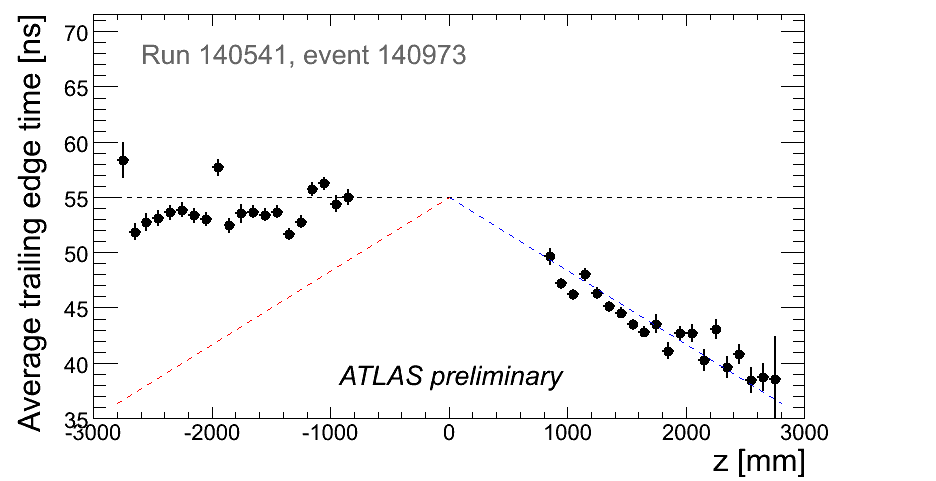
TRTtimeInfo_run140541_event140973_TEcut3_profile.eps

TRTtimeInfo_run140541_event171897_TEcut3_profile.eps

TRTtimeInfo_run140541_event416712_TEcut3_profile.eps
| TRT hit efficiency The following plots show the TRT hit reconstruction efficiency as a function of distance of closest approach of the track to the straw centre, i.e., distance to wire. The hit reconstruction efficiency is defined as the number of straws with a hit on the track divided by the number of straws crossed by the track. Only straws between the first and the last straw crossed by a track with a hit are considered, excluding the first and the last. The 2% of known non-functioning straws are excluded from this study. The tracks are required to have at least one pixel hit, six SCT and fifteen TRT hits; they are also required to have pT > 0.5 GeV, |d0| < 10 mm and |z0| < 300 mm. The efficiency is found to be 94% in the plateau region. The simulated threshold in the Monte Carlo was tuned to match the plateau efficiency measured in data. For similar measurements performed for the barrel using cosmic-rays with significantly larger average momentum, the hit efficiency was found to be 97%. |
 g_eff_locR_trt_b_fit_Distance_to_wire.eps  g_eff_locR_trt_ec_fit_Distance_to_wire.eps |
| Transition radiation onset The plots shows the probability of a TRT high-threshold (HT) hit as a function of the Lorentz factor gamma = E/m for the TRT barrel and end-caps, as measured in 900 GeV LHC collision events (December 2009). At high values of gamma (above 1000), a pure sample of electrons is obtained from photon conversions. For low values of gamma, all selected tracks in the event are used and are assumed to have the mass of the charged pion. As expected from the production of transition radiation (TR), the probability of a HT hit increases for particles with a gamma-factor above 1000, which enables the TRT to separate electrons from pions over a momentum range between 1 GeV and 150 GeV. The electrons are obtained from a sample of photon conversion candidates.These are selected by requiring two oppositely charged tracks, which originate from the same vertex, more than 40mm away from the beam axis. Both tracks are required to have at least four silicon hits and 20 TRT hits.When one track is identified as an electron (fraction of HT hits > 0.12), the other track is considered an electron candidate.The hadron tracks are required to have at least one b-layer hit and 20 TRT hits. Finally, to minimize the contamination of electrons, these tracks are required not to overlap with any conversion candidates. The number of electron candidates is larger and at higher momentum in the end-caps due to the increased amount of material and general boost in the forward directions.The results seem to indicate that the onset of TR from the lower plateau (essentially corresponding to the probability of producing high-energy delta-rays) and the upper plateau (corresponding to the saturation of the transition radiation production in the geometry chosen for the TRT radiators foils and straw tubes) in the end-cap is steeper than for the barrel TRT.This is expected from test-beam measurements and from the different radiator materials used for the barrel (irregularly spaced fibres) and end-caps (regularly spaced foils). The results agree reasonably well with those obtained from minimum bias Monte Carlo simulation, and provide the TRT detector with an excellent starting point to study and optimize its particle identification properties. |
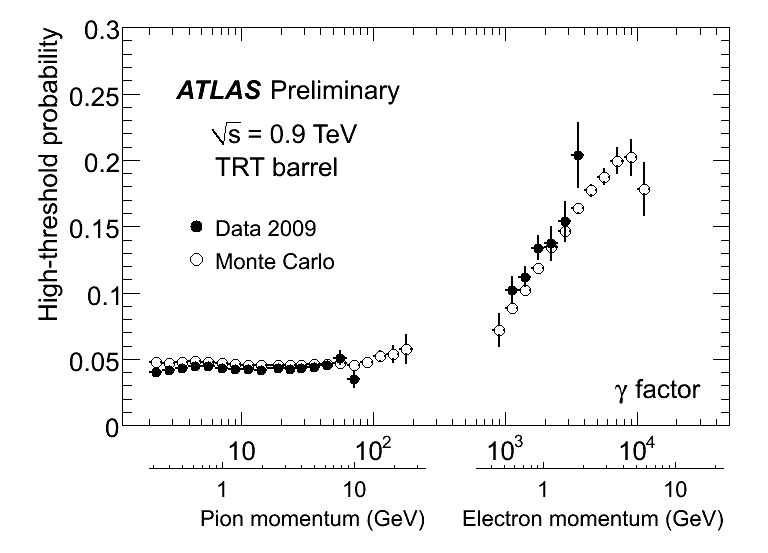 HTonsetBarrel.eps 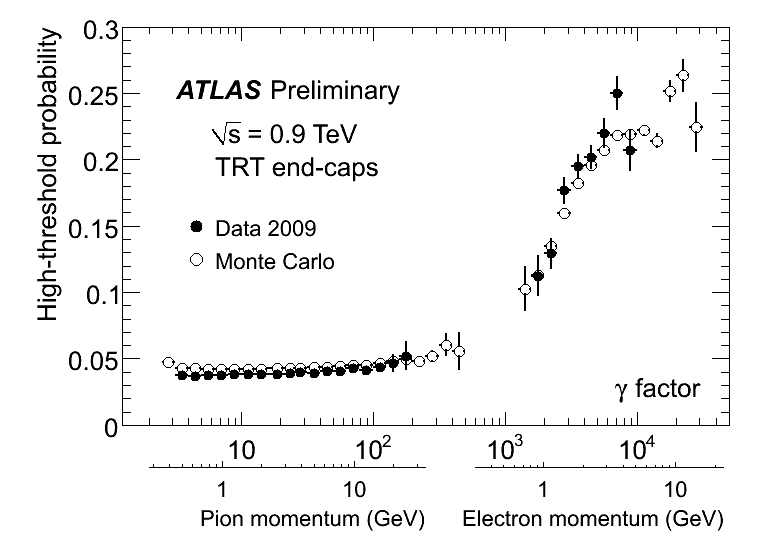 HTonsetEndcap.eps |
| TRT hit position residual The following plots show the TRT unbiased residuals, as obtained from 900 GeV collision data and Monte Carlo, separately for the barrel and end-caps.The Monte Carlo distributions were normalized to the same number of entries as the data. Tracks were required to have: pT > 1 GeV; |d0|<5mm; > 6 hits in SCT or Pixel; >= 14 hits in the TRT. Full-Width-Half-Maximum equivalent of a Gaussian distribution reported in the plots (FWHM/2.35) is comparable to the sigma of a single Gaussian fit: 147 mum (147 mum) and 174 mum (141 mum) for barrel and end-cap data (MC), respectively. For the latter, the fit was iterated until the range corresponded to +/- 1.5*sigma.The mean of the fit for all distributions is smaller in absolute value than 1 mum and is not shown. For these low-momentum tracks, the width of the residual distribution is larger than the intrinsic accuracy per hit expected from the drift-time measurement because of the contribution from multiple scattering to the track parameter errors.The measured resolution in the end-caps is worse than in the barrel and than that expected from the Monte Carlo. More data are required to improve the overall alignment of the inner detector and of the TRT in the end-caps, since their geometry did not permit as detailed studies with cosmic rays as in the barrel. |
 rResidualBarrel.eps  rResidualEndcap.eps |
| The plots show the TRT RT dependency obtained after calibration of run 141749 for the TRT Barrel and Endcaps.
This RT dependency provides the radius that corresponds to the measured drift time and this is needed to create the TRT drift circles used in the track reconstruction. The RT calibration was performed using “combinedInDetTracks” with at least 20 TRT hits and at least 1 SCT hit. The black line corresponds to current result of calibration from run 141749. The blue dashed line in both plots shows the result from cosmic data for Xenon, solenoid field on obtained from the barrel. The RT dependence for collision and cosmic data is the same for the barrel. In the Endcaps there is slight difference for large drift time due to the difference in orientation between the barrel straws and Endcap straws in the magnetic field. This is first time we performed the RT calibration on the Endcaps with real data. |
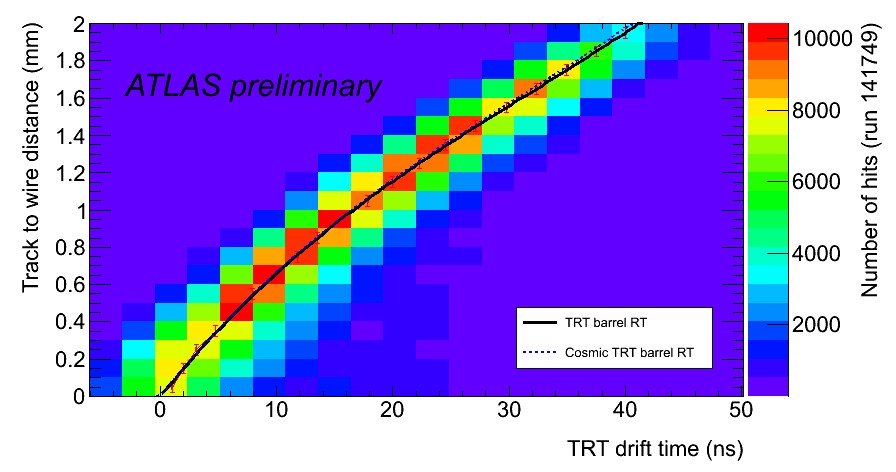 Barrel.eps  Endcaps.eps |
| The TRT event phase distribution for good luminosity blocks of run 141749. The TRT event phase is a measure of the time of the interaction including readout window offset and time of flight effects. It is determined using time measurements of TRT barrel hits on tracks averaging over all Inner Detector tracks with at least 10 TRT barrel hits. The distribution demonstrates the accuracy of the time of event measured with TRT. Quoted sigma is the result of a single Gaussian fit to tange of +- 1.5 sigma around mean (repeating the fit until the result converges). The shift of mean from zero is due to asymmetric distribution of TRT hit time residual distribution. |  ep_AvgShift1DFit_good.eps |
| The event phase for TRT Barrel tracks as a function of the luminosity block number for run 141749 (see above for event phase description). The switch from the ATLAS internal clock to the LHC clock in luminosity block 22 is clearly seen. When using the ATLAS internal clock, event time is spread over 25 ns (one bunch crossing) as the frequencies of the two clocks are different. |  ep_vs_AvgLBShift_good.eps |
| TRT read-out timing as measured in 2009 beam splash data. In beam splash events, there were many particles crossing each single straw. For that reason, leading edge signal (LE, coming from the electron that drifts for shortest distance) comes at the same time for all straws (assuming splash of particles is coming at the same time in different parts of the detector) and we can validate the read-out timing based on measured LE signal time. With 2009 beam splash data, we were able to validate the TRT read-out timing and adjust a few remaining outliers (mostly in end-caps). Good internal synchronization of TRT read-out timing is very important as the variation in measured drift time (see above) is spread over most of the 75 ns read-out window. If part of the detector is read out either too late or too early, hits start falling outside the read-out window and are therefore not recorded. The timing was measured for groups of straws that share the same Trigger Time Control line (TTC line or board; hardware read-out timing can be adjusted on a TTC line level). The top four figures show measured time for different parts of the detector. The one-dimensional distributions show the same in 1D distribution such that spread can be seen. One can see that the timing for all boards was already adjusted with very good precision before 2009 beam splash data (following studies using cosmic and 2008 beam splash data). The remaining few outliers were adjusted before the start of collision data taking. The last plot illustrates time of flight effect in beam splash data, where particles from one beam are coming from one side. Similarly as shown above (using TRT timing to identify collision events), the time of flight effect need to be corrected for on side C (at negative z, for beam 2) as shown on this figure. |

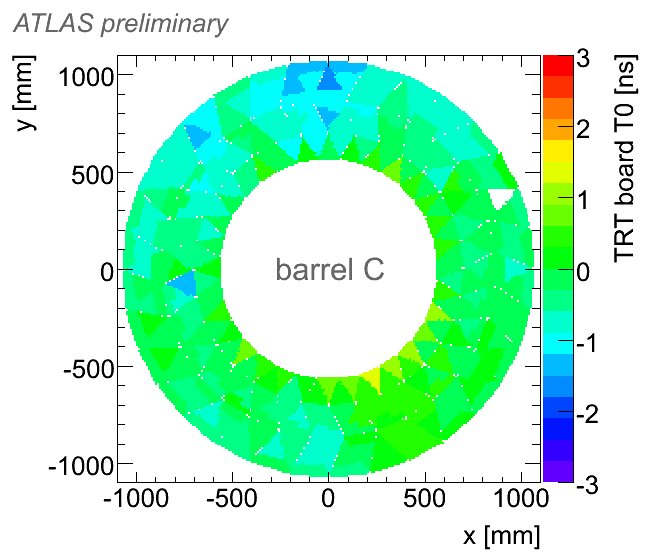 eps file (barrel A) eps file (barrel C)  eps file  eps file  eps file  eps file  eps file |
| A clear-cut description of the figure on the right hand side. | Link to figure, or direct upload to TWiki. Please provide a png (or gif, jpg) and an eps version. Do not forget the "ATLAS preliminary" label on the plot. |
| ... | ... |
Responsible: Project leaders
Last reviewed by: Never reviewed
| I | Attachment | History | Action | Size | Date | Who | Comment |
|---|---|---|---|---|---|---|---|
| |
1.pdf | r1 | manage | 11.6 K | 2011-08-31 - 10:06 | JahredAdelman | |
| |
1.png | r1 | manage | 62.2 K | 2011-08-31 - 10:06 | JahredAdelman | |
| |
1_sim.eps | r1 | manage | 192.2 K | 2011-08-31 - 09:21 | JahredAdelman | |
| |
1_sim.png | r1 | manage | 1.3 K | 2011-08-31 - 09:21 | JahredAdelman | |
| |
2.pdf | r1 | manage | 224.5 K | 2011-08-31 - 10:07 | JahredAdelman | |
| |
2.png | r1 | manage | 118.7 K | 2011-08-31 - 10:07 | JahredAdelman | |
| |
2_sim.eps | r1 | manage | 336.3 K | 2011-08-31 - 09:22 | JahredAdelman | |
| |
2_sim.png | r1 | manage | 1.4 K | 2011-08-31 - 09:22 | JahredAdelman | |
| |
3.pdf | r1 | manage | 188.5 K | 2011-08-31 - 10:07 | JahredAdelman | |
| |
3.png | r1 | manage | 95.3 K | 2011-08-31 - 10:07 | JahredAdelman | |
| |
4.pdf | r1 | manage | 185.2 K | 2011-08-31 - 10:08 | JahredAdelman | |
| |
4.png | r1 | manage | 94.8 K | 2011-08-31 - 10:07 | JahredAdelman | |
| |
5.pdf | r1 | manage | 151.8 K | 2011-08-31 - 10:08 | JahredAdelman | |
| |
5.png | r1 | manage | 73.8 K | 2011-08-31 - 10:08 | JahredAdelman | |
| |
6.pdf | r1 | manage | 137.6 K | 2011-08-31 - 10:08 | JahredAdelman | |
| |
6.png | r1 | manage | 93.1 K | 2011-08-31 - 10:08 | JahredAdelman | |
| |
7.pdf | r1 | manage | 184.6 K | 2011-08-31 - 10:09 | JahredAdelman | |
| |
7.png | r1 | manage | 95.7 K | 2011-08-31 - 10:09 | JahredAdelman | |
| |
8.pdf | r1 | manage | 185.5 K | 2011-08-31 - 10:09 | JahredAdelman | |
| |
8.png | r1 | manage | 93.8 K | 2011-08-31 - 10:04 | JahredAdelman | |
| |
Barrel.eps | r1 | manage | 22.8 K | 2009-12-11 - 22:33 | PippaWells | |
| |
Barrel.png | r1 | manage | 22.3 K | 2009-12-11 - 22:34 | PippaWells | |
| |
BarrelForApproval2.eps | r1 | manage | 16.8 K | 2010-06-01 - 10:12 | SasaFratina | HT onset plot for TRT barrel, 7 TeV data (eps) |
| |
BarrelForApproval2.png | r1 | manage | 19.6 K | 2010-06-01 - 10:06 | SasaFratina | HT onset plot for TRT barrel, 7 TeV data |
| |
BarrelResolution141749.png | r1 | manage | 16.2 K | 2009-12-11 - 22:35 | PippaWells | |
| |
EndcapAandCRes141749.png | r1 | manage | 22.6 K | 2009-12-11 - 22:35 | PippaWells | |
| |
EndcapForApproval2.eps | r1 | manage | 17.8 K | 2010-06-01 - 10:13 | SasaFratina | HT onset plot for TRT end-caps, 7 TeV data (eps) |
| |
EndcapForApproval2.png | r1 | manage | 20.4 K | 2010-06-01 - 10:17 | SasaFratina | HT onset plot for TRT end-caps, 7 TeV data |
| |
Endcaps.eps | r1 | manage | 23.4 K | 2009-12-11 - 22:36 | PippaWells | |
| |
Endcaps.png | r1 | manage | 22.6 K | 2009-12-11 - 22:37 | PippaWells | |
| |
HTFRACTIONEta0vAVERAGEINTPERXINGprof.eps | r1 | manage | 21.1 K | 2012-07-05 - 03:55 | MarkusJuengst | HT fraction pileup (barrel) |
| |
HTFRACTIONEta0vAVERAGEINTPERXINGprof.png | r1 | manage | 20.1 K | 2012-07-05 - 03:55 | MarkusJuengst | HT fraction pileup (barrel) |
| |
HTFRACTIONEta0vNPVprof.eps | r1 | manage | 20.1 K | 2012-07-05 - 04:02 | MarkusJuengst | HT fraction pileup (barrel) |
| |
HTFRACTIONEta0vNPVprof.png | r1 | manage | 21.4 K | 2012-07-05 - 03:55 | MarkusJuengst | HT fraction pileup (barrel) |
| |
HTFRACTIONEta1vAVERAGEINTPERXINGprof.eps | r1 | manage | 21.9 K | 2012-07-05 - 03:57 | MarkusJuengst | HT fraction pileup (transition) |
| |
HTFRACTIONEta1vAVERAGEINTPERXINGprof.png | r1 | manage | 20.6 K | 2012-07-05 - 03:57 | MarkusJuengst | HT fraction pileup (transition) |
| |
HTFRACTIONEta1vNPVprof.eps | r1 | manage | 20.6 K | 2012-07-05 - 03:57 | MarkusJuengst | HT fraction pileup (transition) |
| |
HTFRACTIONEta1vNPVprof.png | r1 | manage | 21.8 K | 2012-07-05 - 03:57 | MarkusJuengst | HT fraction pileup (transition) |
| |
HTFRACTIONEta2vAVERAGEINTPERXINGprof.eps | r1 | manage | 22.5 K | 2012-07-05 - 03:59 | MarkusJuengst | HT fraction pileup (Endcap A) |
| |
HTFRACTIONEta2vAVERAGEINTPERXINGprof.png | r1 | manage | 20.3 K | 2012-07-05 - 03:59 | MarkusJuengst | HT fraction pileup (Endcap A) |
| |
HTFRACTIONEta2vNPVprof.eps | r1 | manage | 20.5 K | 2012-07-05 - 03:59 | MarkusJuengst | HT fraction pileup (Endcap A) |
| |
HTFRACTIONEta2vNPVprof.png | r1 | manage | 21.5 K | 2012-07-05 - 03:59 | MarkusJuengst | HT fraction pileup (Endcap A) |
| |
HTFRACTIONEta3vAVERAGEINTPERXINGprof.eps | r1 | manage | 23.3 K | 2012-07-05 - 04:00 | MarkusJuengst | HT fraction pileup (Endcap A/B) |
| |
HTFRACTIONEta3vAVERAGEINTPERXINGprof.png | r1 | manage | 20.6 K | 2012-07-05 - 04:00 | MarkusJuengst | HT fraction pileup (Endcap A/B) |
| |
HTFRACTIONEta3vNPVprof.eps | r1 | manage | 21.0 K | 2012-07-05 - 04:00 | MarkusJuengst | HT fraction pileup (Endcap A/B) |
| |
HTFRACTIONEta3vNPVprof.png | r1 | manage | 21.5 K | 2012-07-05 - 04:00 | MarkusJuengst | HT fraction pileup (Endcap A/B) |
| |
HTFRACTIONEta4vAVERAGEINTPERXINGprof.eps | r1 | manage | 24.2 K | 2012-07-05 - 04:01 | MarkusJuengst | HT fraction pileup (Endcap B) |
| |
HTFRACTIONEta4vAVERAGEINTPERXINGprof.png | r1 | manage | 20.6 K | 2012-07-05 - 04:01 | MarkusJuengst | HT fraction pileup (Endcap B) |
| |
HTFRACTIONEta4vNPVprof.eps | r1 | manage | 21.8 K | 2012-07-05 - 04:01 | MarkusJuengst | HT fraction pileup (Endcap B) |
| |
HTFRACTIONEta4vNPVprof.png | r1 | manage | 22.0 K | 2012-07-05 - 04:01 | MarkusJuengst | HT fraction pileup (Endcap B) |
| |
HTonsetBarrel.eps | r1 | manage | 15.1 K | 2010-05-03 - 12:10 | SasaFratina | High threshold / transition radiation onset plot (barrel) |
| |
HTonsetBarrel.png | r1 | manage | 18.7 K | 2010-05-03 - 11:48 | SasaFratina | High threshold / transition radiation onset plot (barrel) |
| |
HTonsetEndcap.eps | r1 | manage | 15.7 K | 2010-05-03 - 12:11 | SasaFratina | High threshold / transition radiation onset plot (end-caps) |
| |
HTonsetEndcap.png | r1 | manage | 19.0 K | 2010-05-03 - 11:49 | SasaFratina | High threshold / transition radiation onset plot (end-caps) |
| |
HTonsetFit_CollDataAndMinBiasMC_Endcap_nofit.eps | r1 | manage | 15.0 K | 2009-12-18 - 11:48 | ChristophRembser | TRT turn-on curve for end-caps |
| |
HTonsetFit_CollDataAndMinBiasMC_Endcap_nofit.png | r1 | manage | 37.8 K | 2009-12-18 - 11:47 | ChristophRembser | TRT turn-on curve for end-caps |
| |
LLhitsTrack_run264034_barrel_4.pdf | r1 | manage | 14.7 K | 2015-06-02 - 18:40 | AndrewBeddall | |
| |
LLhitsTrack_run264034_barrel_4.png | r1 | manage | 55.7 K | 2015-06-02 - 19:02 | AndrewBeddall | |
| |
PionRejVsEtaWithMC.eps | r1 | manage | 11.5 K | 2011-10-05 - 14:30 | MarkusJuengst | Pion rejection vs eta |
| |
RTbarrel-20100527.eps | r1 | manage | 22.9 K | 2010-06-01 - 10:02 | SasaFratina | RT relation in TRT barrel, 7 TeV data (eps) |
| |
RTbarrel-20100527.png | r1 | manage | 20.9 K | 2010-06-01 - 09:55 | SasaFratina | RT relation in TRT barrel, 7 TeV data |
| |
RTendcap-20100527.eps | r1 | manage | 23.3 K | 2010-06-01 - 10:04 | SasaFratina | RT relation in TRT end-caps, 7 TeV data (eps) |
| |
RTendcap-20100527.png | r1 | manage | 21.8 K | 2010-06-01 - 09:57 | SasaFratina | RT relation in TRT end-caps, 7 TeV data |
| |
RTrelation_run264034_barrel_4.pdf | r1 | manage | 17.5 K | 2015-06-02 - 18:40 | AndrewBeddall | |
| |
RTrelation_run264034_barrel_4.png | r2 r1 | manage | 74.7 K | 2015-06-02 - 19:02 | AndrewBeddall | |
| |
SumToT_over_SumD_Barrel.eps | r1 | manage | 15.0 K | 2010-06-01 - 12:55 | SasaFratina | electron - pion separation based on time over threshold, 7 TeV data (eps) |
| |
SumToT_over_sumD_Barrel.png | r1 | manage | 22.8 K | 2010-06-01 - 12:41 | SasaFratina | electron - pion separation based on time over threshold, 7 TeV data |
| |
TRTBarrelResidual141749.eps | r1 | manage | 41.8 K | 2009-12-12 - 01:47 | JohnAlison | |
| |
TRTEndcapResidual141749.eps | r1 | manage | 88.6 K | 2009-12-12 - 01:47 | JohnAlison | |
| |
TRT_residual_barrel.eps | r1 | manage | 17.6 K | 2011-10-05 - 14:47 | MarkusJuengst | Residual Barrel |
| |
TRT_residual_endcap.eps | r1 | manage | 16.7 K | 2011-10-05 - 14:48 | MarkusJuengst | Residual Endcap |
| |
TRT_residual_shortstraws.eps | r1 | manage | 17.2 K | 2011-10-05 - 14:48 | MarkusJuengst | Residual Short Straws |
| |
TRTeta.png | r1 | manage | 162.8 K | 2014-03-19 - 12:11 | AndrewBeddall | |
| |
TRTetaPID.png | r1 | manage | 57.8 K | 2014-08-11 - 12:12 | AndrewBeddall | |
| |
TRTtimeInfo_run140541_event140973_TEcut3_profile.eps | r1 | manage | 13.2 K | 2009-12-04 - 04:03 | SasaFratina | timing of event 140973, as measured in TRT |
| |
TRTtimeInfo_run140541_event171897_TEcut3_profile.eps | r1 | manage | 13.2 K | 2009-12-04 - 04:26 | SasaFratina | timing of event 171897 (first collision candidate), as measured in TRT |
| |
TRTtimeInfo_run140541_event171897_TEcut3_profile.png | r1 | manage | 18.0 K | 2009-12-04 - 04:00 | SasaFratina | timing of event 171897 (first collision candidate), as measured in TRT |
| |
TRTtimeInfo_run140541_event416712_TEcut3_profile.eps | r1 | manage | 13.2 K | 2009-12-04 - 04:27 | SasaFratina | timing of event 416712 (di-jet candidate), as measured in TRT |
| |
TRTtimeInfo_run140541_event416712_TEcut3_profile.png | r1 | manage | 18.4 K | 2009-12-04 - 04:01 | SasaFratina | timing of event 416712 (di-jet candidate), as measured in TRT |
| |
approv-ToTsumGT01vsP_data-label.eps | r1 | manage | 7127.0 K | 2010-09-29 - 15:10 | JahredAdelman | ToT estimator outside primary vertex |
| |
approv-ToTsumGT01vsP_data-label.png | r1 | manage | 166.4 K | 2010-09-29 - 15:10 | JahredAdelman | ToT estimator outside primary vertex |
| |
approv-ToTsumLT01vsP_data-label.eps | r1 | manage | 10120.1 K | 2010-09-29 - 15:09 | JahredAdelman | ToT estimator from primary vertex |
| |
approv-ToTsumLT01vsP_data-label.png | r1 | manage | 221.9 K | 2010-09-29 - 15:09 | JahredAdelman | ToT estimator from primary vertex |
| |
barrel.eps | r1 | manage | 18.3 K | 2011-08-31 - 09:28 | JahredAdelman | |
| |
barrel.png | r1 | manage | 68.3 K | 2011-08-31 - 09:26 | JahredAdelman | |
| |
barrelHT.eps | r1 | manage | 18.1 K | 2011-08-31 - 09:55 | JahredAdelman | |
| |
barrelHT.png | r1 | manage | 64.5 K | 2011-08-31 - 09:55 | JahredAdelman | |
| |
barrelHT_delta.eps | r1 | manage | 15.8 K | 2011-08-31 - 09:56 | JahredAdelman | |
| |
barrelHT_delta.png | r1 | manage | 54.3 K | 2011-08-31 - 09:25 | JahredAdelman | |
| |
barrel_delta.eps | r1 | manage | 15.6 K | 2011-08-31 - 09:24 | JahredAdelman | |
| |
barrel_delta.png | r1 | manage | 53.9 K | 2011-08-31 - 09:24 | JahredAdelman | |
| |
barrel_prediction.eps | r2 r1 | manage | 11.9 K | 2011-08-31 - 10:32 | JahredAdelman | |
| |
barrel_prediction.png | r2 r1 | manage | 38.1 K | 2011-08-31 - 10:32 | JahredAdelman | |
| |
barrel_prediction_HT.eps | r2 r1 | manage | 13.5 K | 2011-08-31 - 10:32 | JahredAdelman | |
| |
barrel_prediction_HT.png | r2 r1 | manage | 37.3 K | 2011-08-31 - 10:31 | JahredAdelman | |
| |
barrel_residuals.eps | r1 | manage | 9.9 K | 2011-08-31 - 09:29 | JahredAdelman | |
| |
barrel_residuals.png | r1 | manage | 20.2 K | 2011-08-31 - 09:27 | JahredAdelman | |
| |
beamSplashTiming_barrelA_color.eps | r1 | manage | 448.8 K | 2010-10-07 - 11:47 | SasaFratina | barrel A timing (2009 beam splash data) - eps |
| |
beamSplashTiming_barrelA_color.png | r1 | manage | 21.4 K | 2010-02-08 - 03:21 | SasaFratina | barrel A timing (2009 beam splash data) |
| |
beamSplashTiming_barrelC_color.eps | r1 | manage | 448.7 K | 2010-10-07 - 11:48 | SasaFratina | barrel C timing (2009 beam splash data) - eps |
| |
beamSplashTiming_barrelC_color.png | r1 | manage | 21.6 K | 2010-02-08 - 03:21 | SasaFratina | barrel C timing (2009 beam splash data) |
| |
beamSplashTiming_barrel_distribution_140370.eps | r1 | manage | 11.5 K | 2010-10-07 - 11:53 | SasaFratina | barrel timing - distribution (2009 beam splash data) - eps |
| |
beamSplashTiming_barrel_distribution_140370.png | r1 | manage | 17.3 K | 2010-02-08 - 03:24 | SasaFratina | barrel timing - distribution (2009 beam splash data) |
| |
beamSplashTiming_endcapA_color_140370.eps | r1 | manage | 29.6 K | 2010-10-07 - 11:51 | SasaFratina | end-cap A timing (2009 beam splash data) - eps |
| |
beamSplashTiming_endcapA_color_140370.png | r1 | manage | 15.3 K | 2010-02-08 - 03:22 | SasaFratina | end-cap A timing (2009 beam splash data) |
| |
beamSplashTiming_endcapC_color_140370.eps | r1 | manage | 29.2 K | 2010-10-07 - 11:51 | SasaFratina | end-cap C timing (2009 beam splash data) - eps |
| |
beamSplashTiming_endcapC_color_140370.png | r1 | manage | 15.3 K | 2010-02-08 - 03:23 | SasaFratina | end-cap C timing (2009 beam splash data) |
| |
beamSplashTiming_endcap_ToF.eps | r1 | manage | 21.9 K | 2010-10-07 - 11:54 | SasaFratina | beam splash - time of flight in end-caps - eps |
| |
beamSplashTiming_endcap_ToF.png | r1 | manage | 16.7 K | 2010-02-08 - 03:25 | SasaFratina | beam splash - time of flight in end-caps |
| |
beamSplashTiming_endcap_distribution_140370.eps | r1 | manage | 11.2 K | 2010-10-07 - 11:53 | SasaFratina | end-cap A timing - distribution (2009 beam splash data) - eps |
| |
beamSplashTiming_endcap_distribution_140370.png | r1 | manage | 17.1 K | 2010-02-08 - 03:24 | SasaFratina | end-cap timing - distribution (2009 beam splash data) |
| |
driftTime_run264034_barrel_4.pdf | r1 | manage | 14.5 K | 2015-06-02 - 18:40 | AndrewBeddall | |
| |
driftTime_run264034_barrel_4.png | r1 | manage | 57.4 K | 2015-06-02 - 19:02 | AndrewBeddall | |
| |
endcap.eps | r1 | manage | 12.4 K | 2011-08-31 - 09:26 | JahredAdelman | |
| |
endcap.png | r1 | manage | 35.2 K | 2011-08-31 - 09:26 | JahredAdelman | |
| |
endcapHT.eps | r1 | manage | 12.2 K | 2011-08-31 - 09:56 | JahredAdelman | |
| |
endcapHT.png | r1 | manage | 35.4 K | 2011-08-31 - 09:55 | JahredAdelman | |
| |
endcapHT_delta.eps | r1 | manage | 11.3 K | 2011-08-31 - 09:28 | JahredAdelman | |
| |
endcapHT_delta.png | r1 | manage | 30.2 K | 2011-08-31 - 09:26 | JahredAdelman | |
| |
endcap_delta.eps | r1 | manage | 11.1 K | 2011-08-31 - 09:56 | JahredAdelman | |
| |
endcap_delta.png | r1 | manage | 28.7 K | 2011-08-31 - 09:57 | JahredAdelman | |
| |
endcap_prediction.eps | r2 r1 | manage | 9.6 K | 2011-08-31 - 10:32 | JahredAdelman | |
| |
endcap_prediction.png | r2 r1 | manage | 23.6 K | 2011-08-31 - 10:31 | JahredAdelman | |
| |
endcap_prediction_HT.eps | r2 r1 | manage | 8.8 K | 2011-08-31 - 10:32 | JahredAdelman | |
| |
endcap_prediction_HT.png | r2 r1 | manage | 22.4 K | 2011-08-31 - 10:31 | JahredAdelman | |
| |
endcap_residuals.eps | r1 | manage | 10.3 K | 2011-08-31 - 09:29 | JahredAdelman | |
| |
endcap_residuals.png | r1 | manage | 22.5 K | 2011-08-31 - 09:27 | JahredAdelman | |
| |
ep_AvgShift1DFit_good.eps | r1 | manage | 9.3 K | 2009-12-11 - 22:39 | PippaWells | |
| |
ep_AvgShift1DFit_good.png | r1 | manage | 12.7 K | 2009-12-11 - 22:39 | PippaWells | |
| |
ep_vs_AvgLBShift_good.eps | r1 | manage | 35.6 K | 2009-12-11 - 22:39 | PippaWells | |
| |
ep_vs_AvgLBShift_good.png | r1 | manage | 14.8 K | 2009-12-11 - 22:40 | PippaWells | |
| |
g_eff_locR_trt_b_fit.eps | r1 | manage | 13.0 K | 2010-06-01 - 10:30 | SasaFratina | TRT hit efficiency in 7 TeV data, barrel (eps) |
| |
g_eff_locR_trt_b_fit.png | r1 | manage | 20.8 K | 2010-06-01 - 10:28 | SasaFratina | TRT hit efficiency in 7 TeV data, barrel |
| |
g_eff_locR_trt_b_fit_Distance_to_wire.eps | r1 | manage | 12.4 K | 2010-05-11 - 11:43 | SasaFratina | TRT hit efficiency in 900 GeV data, barrel |
| |
g_eff_locR_trt_b_fit_Distance_to_wire.png | r1 | manage | 16.2 K | 2010-05-11 - 11:45 | SasaFratina | TRT hit efficiency in 900 GeV data, barrel |
| |
g_eff_locR_trt_ec_fit.eps | r1 | manage | 13.0 K | 2010-06-01 - 10:31 | SasaFratina | TRT hit efficiency in 7 TeV data, end-caps (eps) |
| |
g_eff_locR_trt_ec_fit.png | r1 | manage | 20.8 K | 2010-06-01 - 10:29 | SasaFratina | TRT hit efficiency in 7 TeV data, end-caps |
| |
g_eff_locR_trt_ec_fit_Distance_to_wire.eps | r1 | manage | 12.3 K | 2010-05-11 - 11:46 | SasaFratina | TRT hit efficiency in 900 GeV data, end-caps |
| |
g_eff_locR_trt_ec_fit_Distance_to_wire.png | r1 | manage | 16.4 K | 2010-05-11 - 11:44 | SasaFratina | TRT hit efficiency in 900 GeV data, end-caps |
| |
h_pResidualvsRadiusZ_Barrel_sigma.TRTPerformanceNote.eps | r2 r1 | manage | 86.3 K | 2011-08-31 - 10:36 | JahredAdelman | |
| |
h_pResidualvsRadiusZ_Barrel_sigma.TRTPerformanceNote.png | r2 r1 | manage | 59.5 K | 2011-08-31 - 10:36 | JahredAdelman | |
| |
h_pResidualvsRadiusZ_EndcapA_sigma.TRTPerformanceNote.eps | r2 r1 | manage | 87.2 K | 2011-08-31 - 10:36 | JahredAdelman | |
| |
h_pResidualvsRadiusZ_EndcapA_sigma.TRTPerformanceNote.png | r2 r1 | manage | 61.6 K | 2011-08-31 - 10:36 | JahredAdelman | |
| |
h_residual_Barrel_run182787.png | r1 | manage | 103.4 K | 2011-10-05 - 14:44 | MarkusJuengst | Residual Barrel |
| |
h_residual_Endcap_run182787.png | r1 | manage | 97.3 K | 2011-10-05 - 14:44 | MarkusJuengst | Residual Endcap |
| |
h_residual_Shortstraws_run182787.png | r1 | manage | 103.4 K | 2011-10-05 - 14:45 | MarkusJuengst | Residual Short Straws |
| |
profile_allHT_new_vertex_run182787.png | r1 | manage | 92.7 K | 2011-10-05 - 14:46 | MarkusJuengst | Occupancy vs Nvtx all |
| |
profile_allHT_vertex.eps | r1 | manage | 12.5 K | 2011-10-05 - 14:47 | MarkusJuengst | Occupancy vs Nvtx HT |
| |
profile_all_new_vertex_run182787.png | r1 | manage | 95.6 K | 2011-10-05 - 14:45 | MarkusJuengst | Occupancy vs Nvtx all |
| |
profile_all_vertex.eps | r1 | manage | 13.0 K | 2011-10-05 - 14:46 | MarkusJuengst | Occupancy vs Nvtx all |
| |
rResidualBarrel.eps | r1 | manage | 12.9 K | 2010-05-03 - 12:11 | SasaFratina | Hit position residual (barrel) |
| |
rResidualBarrel.png | r1 | manage | 17.5 K | 2010-05-03 - 11:56 | SasaFratina | Hit position residual (barrel) |
| |
rResidualEndcap.eps | r1 | manage | 12.9 K | 2010-05-03 - 12:11 | SasaFratina | Hit position residual (end-caps) |
| |
rResidualEndcap.png | r1 | manage | 18.1 K | 2010-05-03 - 11:56 | SasaFratina | Hit position residual (end-caps) |
| |
residualD_run264034_barrel_4.pdf | r1 | manage | 15.8 K | 2015-06-02 - 18:40 | AndrewBeddall | |
| |
residualD_run264034_barrel_4.png | r1 | manage | 61.3 K | 2015-06-02 - 19:02 | AndrewBeddall | |
| |
residualT_run264034_barrel_4.pdf | r1 | manage | 18.3 K | 2015-06-02 - 18:40 | AndrewBeddall | |
| |
residualT_run264034_barrel_4.png | r1 | manage | 65.1 K | 2015-06-02 - 19:02 | AndrewBeddall | |
| |
residuals_vertex.eps | r1 | manage | 9.4 K | 2011-08-31 - 09:29 | JahredAdelman | |
| |
residuals_vertex.png | r1 | manage | 19.7 K | 2011-08-31 - 09:27 | JahredAdelman | |
| |
tResBarrel.eps | r1 | manage | 14.1 K | 2011-10-05 - 14:41 | MarkusJuengst | Time Residual in Barrel |
| |
tResEndcap.eps | r1 | manage | 12.7 K | 2011-10-05 - 14:42 | MarkusJuengst | Time Residual Endcap |
| |
time_resolution_Barrel_run182787.png | r1 | manage | 134.5 K | 2011-10-05 - 14:42 | MarkusJuengst | Time Residual in Barrel |
| |
time_resolution_Endcap_run182787.png | r1 | manage | 121.4 K | 2011-10-05 - 14:43 | MarkusJuengst | Time Residual Endcap |
| |
tubes_vs_p_vxp.eps | r1 | manage | 55.7 K | 2011-08-31 - 09:29 | JahredAdelman | |
| |
tubes_vs_p_vxp.png | r1 | manage | 58.7 K | 2011-08-31 - 09:27 | JahredAdelman |
Topic revision: r59 - 2023-11-03 - AndrewBeddall
or Ideas, requests, problems regarding TWiki? use Discourse or Send feedback


